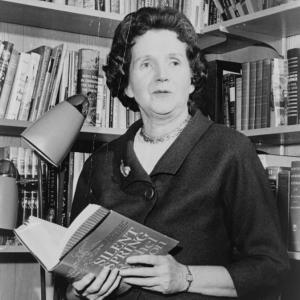Rachel Louise Carson was born on May 27, 1907 on a farm in Springdale, Pennsylvania. She was influenced by her mother to love nature, further explaining her future interests in the field of environmental science. She started out by writing children’s magazines at the age of 10 and later on attended the Pennsylvania College for Women. After graduating magna cum laude in 1929, she studied at an oceanographic institute in Massachusetts. Later in 1932, she earned a degree in zoology at the John Hopkins University. However, she was forced to abandon her pursuit of a doctorate degree due to the financial struggles troubling her family, most likely resulting from the Great Depression.
In 1936, Carson applied to take a civil service exam and received a high score. She was then offered and accepted the job of writing brochures and other papers for the public at the US Bureau of Fisheries. After 15 years of writing public material, she was promoted to Editor-in-Chief of all publications for the US Fish and Wildlife Service. Her writing experiences at her first job truly explain why she was able to captivate a large and broad audience for her future books.
Carson wrote various popular books on aquatic life such as Under the Sea Wind (1941) and The Sea Around Us (1951). Both books focused on teaching people about the beauty of their environment. Later on, she won the Natural Book Award, which financially assisted and enabled her to move to Southport Island, Maine in 1953.
However, in the 1940s, a new chemical, DDT was synthesized. It was used to fight insect-borne diseases like malaria and typhus, but it was also known to be very effective as an insecticide. Thus, do to its success in agriculture, it was heavily used in the U.S. During this time, Carson acknowledged the negative impacts that DDT had on not only nature, but also human health. Unfortunately, her first attempt to spread awareness about DDT was when she wrote to Reader’s Digest asking them to write up an article on research conducted on DDT, but her request was denied.
Thirteen years later, encouraged by a letter of complaint about DDT, she wrote her most renowned book that many acknowledge today, Silent Spring. The book was published in September of 1962 and it discussed DDT’s correlation with cancer and genetic damage, impact on the food chain, how strong of a contaminant it was, and more. Not only did she write about DDT, she also talked about how harmful all pesticides and insecticides were to humans and the environment.
Her book had a drastic impact on the public’s perspectives of pesticides, insecticides, and agriculture. Silent Spring aroused public concerns for the misuse of pesticides and for the advocacy of better pesticide control laws. Sadly, Rachel Carson died at the age of 56, combating breast cancer on April 14, 1964, but her book remained a success and had achieved her long-term goal of educating the majority about the negatives aspects of DDT. In 1972, the U.S. Environmental Protection Agency announced the ban or a heavy restriction on DDT due to its correlation between reproduction effects, cancer, and other diseases as well as its harmful effects on the environmental ecosystem.
Today, we still acknowledge Rachel Carson’s efforts as well as her most successful book, Silent Spring. Her work inspires many young people today and encourages us to still take care of our environment not only for the ecosystems, but also for our own good.

Rachel Carson's 1928 Yearbook Portrait, Rachel Carson's portrait from the 1928 Pennsylvanian. Credit: Unknown/Chatham University (Carson’s college).

Rachel Carson conducts Marine Biology Research with Bob Hines — in the Atlantic (1952). Credit: U.S. Fish and Wildlife Service

Photo of Rachel Carson at a dock. Credit: U.S. Department of Agriculture/Flickr

Ford tri-motor spraying DDT. Photo by R.B. Pope, July 1955 Credit: USDA Forest Service.

Rachel Carson and her book, Silent Spring. Credit: National Women’s History Museum.

Rachel Carson | by International Livestock Research Institute

Rachel Carson Preserve | by billandkent